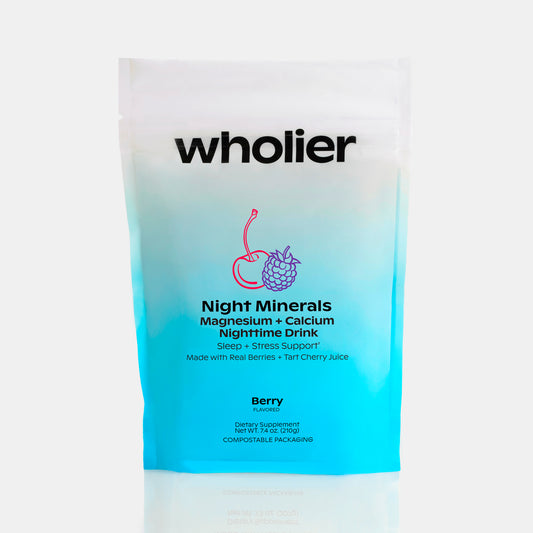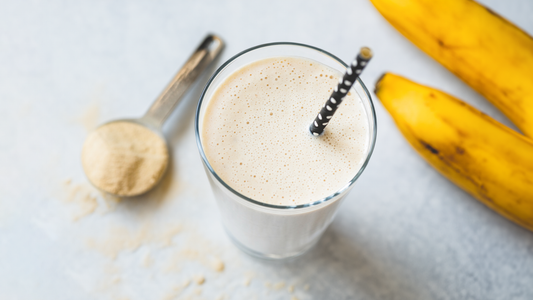
Is Magnesium Oxide a Good Form of Magnesium?
Magnesium is a lot more than just a number on the periodic table. As one of the essential minerals in our bodies, magnesium plays an integral role in maintaining our overall health and wellness. You'll find it in your bones, muscles, and even in your DNA. But, there's a catch. Our bodies don't naturally produce magnesium. Instead, we rely on our diet to supply us with this vital nutrient.(1)
Interestingly, every cell in your body needs magnesium to function. It aids in protein synthesis, supports muscle and nerve function, helps regulate blood glucose levels, and even contributes to bone development.(2) One striking fact about magnesium is its role in the process of energy production. ATP (adenosine triphosphate), the main source of energy in cells, must bind to a magnesium ion (Mg2+) in order to be biologically active. So, in essence, without magnesium, our bodies cannot produce or use energy effectively.(3)
What Are the Different Forms of Magnesium and What Is Bioavailability?
Now that we understand the importance of magnesium, let's dive into its various forms. The form of magnesium you consume matters because it impacts its bioavailability - a term that refers to the extent and rate at which a nutrient is absorbed and used in the body.(4) So, when we discuss different forms of magnesium, we're actually talking about how well our bodies can utilize this essential nutrient.
The world of dietary supplements introduces us to many forms of magnesium. Magnesium oxide, magnesium citrate, magnesium glycinate, and magnesium chloride are just a few examples. But why so many forms? The answer lies in the 'carrier' molecule - the other component that binds with magnesium to enhance its stability, digestibility, or absorption. These carriers significantly influence the form's bioavailability and health benefits.(5)
And then comes the 'organic' vs. 'inorganic' distinction. Organic forms of magnesium, like citrate or glycinate, are bound to molecules that occur naturally in life forms (think citric acid or amino acids). On the other hand, inorganic forms, such as magnesium oxide or chloride, are combined with a mineral, like oxygen or chlorine(6). As a general rule, organic forms tend to have higher bioavailability, meaning they are more readily absorbed and used by our bodies.(7)
Is Magnesium Oxide a Good Form of Magnesium?
Given the choice of different forms, many people question whether magnesium oxide is a good form of magnesium to supplement with. The truth is, while it's a popular form due to its high magnesium content per weight, the bioavailability of magnesium oxide is notably low. A clinical study found that only about 4% of magnesium oxide is absorbed by the body, compared to other forms like citrate and glycinate.(8)
Another research points out the same fact; it showed that the fractional absorption of magnesium from magnesium oxide was significantly lower than from magnesium citrate.(9) Yet another study suggests that when compared to other forms, magnesium oxide induced the lowest increase in serum magnesium concentration.(10)
While this may seem like scientific jargon, bioavailability is crucial to truly reap the benefits of magnesium. Many people begin using magnesium supplements for their sleep-enhancing, muscle recovery-promoting, and stress-reducing benefits. If you're taking a form with lower bioavailability, you're less likely to experience the advantages of magnesium supplementation. In the case of magnesium oxide, you might have to take up to four times more to absorb the same amount as a form like citrate.(11)

Why Are Magnesium Glycinate and Citrate Better Choices?
While magnesium oxide might not be the most bioavailable, other forms of magnesium, like glycinate and citrate, are often better choices.
Magnesium glycinate, an organic form, has a high bioavailability because it's bound to glycine, an amino acid that our bodies readily recognize and absorb. It's also gentle on the stomach, making it a popular choice for those looking to improve sleep and mental well-being.(12)
Similarly, magnesium citrate has superior absorption compared to oxide. It's bound to citric acid, which increases its solubility and thus its bioavailability. It's often used to aid digestion, as it naturally attracts water through the tissues it passes, softening stools and acting as a gentle laxative.(13)
A comparative study on the bioavailability of magnesium citrate and magnesium oxide found that magnesium citrate was significantly more soluble and bioavailable than magnesium oxide.(14) Another study highlights that magnesium citrate led to the greatest mean serum magnesium concentration compared with other treatments.(15)
These forms can be found individually or as a blend, as in our Night Minerals Magnesium and Calcium Drink. The combination of these bioavailable forms of magnesium allows you to experience the unique benefits of each.
So, What's the Verdict on Magnesium Oxide?
In the realm of health and nutrition, magnesium is undeniably vital. While magnesium oxide offers a high amount of elemental magnesium, its bioavailability is disappointingly low, potentially limiting its effectiveness as a supplement.(16)
Meanwhile, other forms like magnesium glycinate and magnesium citrate, with their high bioavailability and specific health benefits, are better choices for those looking to experience the endless benefits of this essential mineral.
Sources:
(1) Gröber, U., Schmidt, J., & Kisters, K. (2015). Magnesium in Prevention and Therapy. Nutrients, 7(9), 8199–8226.
(2) de Baaij, J.H.F., Hoenderop, J.G.J., & Bindels, R.J.M. (2015). Magnesium in man: implications for health and disease. Physiological reviews, 95(1), 1-46.
(3) Romani, A. M. P. (2013). Cellular magnesium homeostasis. Archives of Biochemistry and Biophysics, 512(1), 1-23.
(4) Heaney, R.P. (2001). Factors Influencing the Measurement of Bioavailability, Taking Calcium as a Model. The Journal of Nutrition, 131(4), 1344S-1348S.
(5) Coudray, C., Rambeau, M., Feillet-Coudray, C., Gueux, E., Tressol, J. C., Mazur, A., & Rayssiguier, Y. (2005). Study of magnesium bioavailability from ten organic and inorganic Mg salts in Mg-depleted rats using a stable isotope approach. Magnesium research, 18(4), 215-223.
(6) Schuchardt, J.P., & Hahn, A. (2017). Intestinal Absorption and Factors Influencing Bioavailability of Magnesium- An Update. Current Nutrition & Food Science, 13(4), 260-278.
(7) Firoz, M., & Graber, M. (2001). Bioavailability of US commercial magnesium preparations. Magnesium Research, 14(4), 257-262.
(8) Lindberg, J. S., Zobitz, M. M., Poindexter, J. R., & Pak, C. Y. C. (1990). Magnesium bioavailability from magnesium citrate and magnesium oxide. Journal of the American College of Nutrition, 9(1), 48-55.
(9) Walker, A.F., Marakis, G., Christie, S., & Byng, M. (2003). Mg citrate found more bioavailable than other Mg preparations in a randomised, double-blind study. Magnesium Research, 16(3), 183-191.
(10) Bøhmer, T., & Røseth, A. (1990). Bioavailability of oral magnesium supplementation in female students evaluated from elimination of magnesium in 24-hour urine. Magnesium and trace elements, 9(5), 272-278.
(11) Firoz, Mansoor, and Michael Graber. 2001. "Bioavailability of US Commercial Magnesium Preparations." Magnesium Research 14, no. 4: 257-62.
(12) Boyle, N.B., Lawton, C., & Dye, L. (2017). The Effects of Magnesium Supplementation on Subjective Anxiety and Stress—A Systematic Review. Nutrients, 9(5), 429.
(13) Lindberg, J. S., Zobitz, M. M., Poindexter, J. R., & Pak, C. Y. C. (1990). Magnesium bioavailability from magnesium citrate and magnesium oxide. Journal of the American College of Nutrition, 9(1), 48-55.
(14) Schuette, S. A., Lashner, B. A., & Janghorbani, M. (1994). Bioavailability of magnesium diglycinate vs magnesium oxide in patients with ileal resection. Journal of Parenteral and Enteral Nutrition, 18(5), 430-435.
(15) Coudray, C., Rambeau, M., Feillet-Coudray, C., Gueux, E., Tressol, J. C., Mazur, A., & Rayssiguier, Y. (2005). Study of magnesium bioavailability from ten organic and inorganic Mg salts in Mg-depleted rats using a stable isotope approach. Magnesium research, 18(4), 215-223.
(16) Ranade, V.V., & Somberg, J.C. (2001). Bioavailability and Pharmacokinetics of Magnesium After Administration of Magnesium Salts to Humans. American Journal of Therapeutics, 8(5), 345-357.





